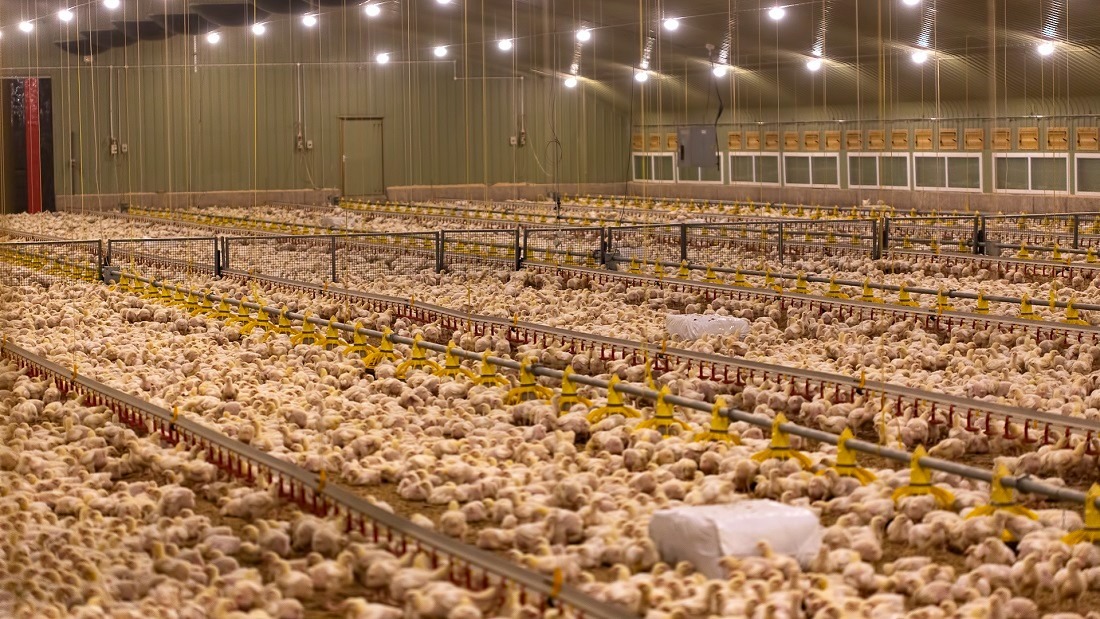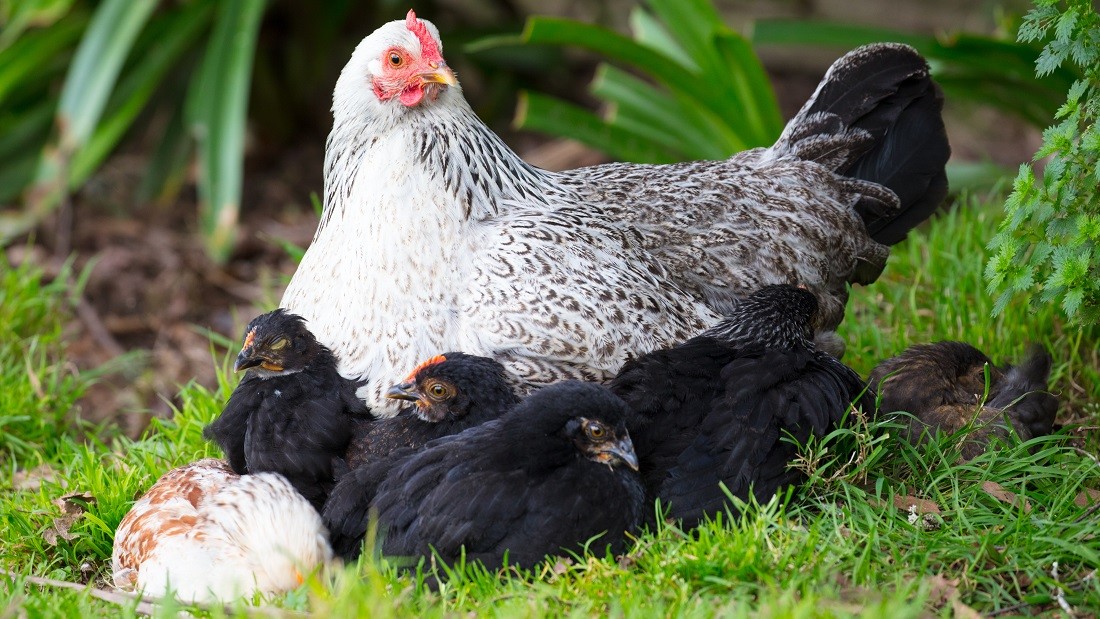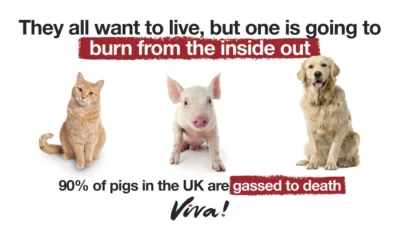Bird Brain: How chickens think & feel

By Juliet Gellatley, founder & director, Viva! (BSc Zoology)
Chicken farming, in particular, is the epitome of life is cheap. ‘Everyday’ whole chickens sell for £2.48 at Tesco. All that suffering for £2.48. The numbers are crazy, close to one billion little lives wiped out each year in the UK alone. So much cruelty on a mind-boggling scale. And so often excused by ignorance: “but chickens are stupid”, “they don’t feel or have emotions” and even, “are chickens animals?”
On the one hand society celebrates wild birds, noting how smart they are; and on the other, relegates chickens as unintelligent, worthless animals. In the animal kingdom, birds display many remarkable skills once thought to be restricted to humans: magpies recognise themselves in a mirror; New Caledonian crows make tools; African grey parrots count and categorise objects by colour and shape.
Few people think about chickens as intelligent or emotional, however scientists (and people who live with hens) have learned that these birds can be cunning and wily, and can communicate in sophisticated ways that are on a par with some primates – just as the cognitive abilities of the crow family are equal to chimps and gorillas. Roosters protect females. Chickens solve complex problems and mother hens emotionally empathise with their chicks.
A recent review in Scientific American of studies on chicken intelligence concludes: “chickens are smart and they understand their world, which raises troubling questions about how they are treated on factory farms.”1Smith CL, Zielinski SL. 2014. Brainy Bird. Sci Am; 310(2):60-65. Indeed, researchers at Macquarie University in Sydney, Australia recently found that chickens’ high level of intelligence made studying them a challenge.
On multiple occasions birds would deliberately subvert experiments to their advantage. One example was a hen named 007. Studied in large outdoor spaces with lots of vegetation, an enclosed area was set up with TV footage of a cockerel shaking his wattle, which a female finds very attractive because it means he has found food for her (and the larger the wattle the more testosterone – isn’t that the way?!). While waiting for the door to open, 007 got impatient and examined the release mechanism closely, turning her head from side to side. After a few moments, she carefully plucked the wire that controlled the latch. The door opened and 007 got what she wanted, to be close to the guy and his food. After that, she would never wait again. Although the latch configuration was changed several times, 007 was always able to solve the puzzle.1Smith CL, Zielinski SL. 2014. Brainy Bird. Sci Am; 310(2):60-65.
Scientists have known since the 1940s that roosters perform complex visual displays when they find food, to attract the ladies. The most prominent display is called tidbitting, where the boss man (alpha male) food calls and rhythmically repeats movements of his head and neck, including picking up and dropping a food item.2Smith CL, Van Dyk DA, Taylor PW, Evans CS. 2009. On the function of an enigmatic ornament: wattles increase the conspicuousness of visual displays in male fowl. Anim Behav; 78(6):1433-1440. The females respond and approach the fancy male to accept their gift, the dominant females likely winning the morsels. The twist in the story is that the social antics of chickens are not that simple!

Because the birds are often secretive, hidden in long grass and bushes, human observers had missed the underlying dramas, showing that subordinate males can be – and I quote: “devious bastards!”11. Smith CL, Zielinski SL. 2014. Brainy Bird. Sci Am; 310(2):60-65. However, with the aid of multiple high-definition cameras and advanced recording techniques, birds in small groups in large outdoor enclosures were monitored and it is now known that subordinate males use “surreptitious techniques in a way previously thought impossible for the birds”2Smith CL, Van Dyk DA, Taylor PW, Evans CS. 2009. On the function of an enigmatic ornament: wattles increase the conspicuousness of visual displays in male fowl. Anim Behav; 78(6):1433-1440. to attract females without being chased and pecked by alpha males. They perform only the visual part of tidbitting, without the ‘food’ calling.3Smith CL, Taylor A, Evans CS. 2011. Tactical multimodal signalling in birds: facultative variation in signal modality reveals sensitivity to social costs. Anim Behav; 82:521-527. To those who live with hens, this is not surprising, but scientists were shocked to find the range of behavioural flexibility and conscious judgments being made by chickens.
Like humans, chickens are now known to tailor their messages for their audience. A cockerel that sees a threat overhead, for example, makes an alarm call if he knows a female is nearby, but remains silent in the presence of a rival male.4Kokolakis A, Smith CL, Evans, CS. 2010. Aerial alarm calling by male fowl (Gallus gallus) reveals subtle new mechanisms of risk management. Anim Behav; 79(6):1373–1380. It was also found that males would take more risks if they felt safe. Like humans, chickens take more risks if they perceive a mitigating factor. So, for example, we drive faster when wearing a seat belt. Chickens alarm call more if they are safely under a bush.11. Smith CL, Zielinski SL. 2014. Brainy Bird. Sci Am; 310(2):60-6555. Smith CL, Johnson J. 2012. The chicken challenge: what contemporary studies of fowl mean for science and ethics. Between the Species; 15 (1): 75-102. Available from: http://digitalcommons.calpoly.edu/bts/
Furthermore, chickens have a repertoire of different sounds which convey specific information, understood by other chickens. So, for example, one chicken can tell another: “there is a hawk above” or “a fox is nearby” and the language will be understood without the listening bird seeing the hawk or fox. Animal behaviourists liken this to a person being able to comprehend and respond to words. Scientists now accept that chickens think before they act – a trait more typically associated with large-brained mammals.
Empathy used to be thought of as a human-only trait. That just illustrates our own severe limitations in understanding other species. It is now accepted by scientists that mother hens feel emotional empathy for their chicks. Researchers at Bristol University studied hens whose chicks received a harmless puff of air that ruffled their downy plumage.6Edgar JL, Lowe JC, Paul ES, Nicol CJ. 2011. Avian maternal response to chick distress. Proc Biol Sci; 278(1721):3129-3134. The chicks viewed the puff as potentially harmful and showed classic stress signs including increased heart rate. Although the mother hens knew that the puff of air was harmless (they didn’t react if given a puff of air themselves), they became upset if their chicks showed distress from the puffing. The mother hens became stressed and clucked more to their chicks. According to animal communication and cognition researcher Carolynn Smith at Macquarie University, this means that “chickens can take the perspective of other birds” which has enormous implications for the way that breeder hens and broiler chickens are treated.11. Smith CL, Zielinski SL. 2014. Brainy Bird. Sci Am; 310(2):60-65
Christine Nicol, Professor of Animal Welfare at Bristol University recently reviewed 20 years of research on chicken intelligence and challenges the convenient ignorance that pervades society, saying it is just plain wrong to think of chickens as being stupid. Instead, we should realise that the birds have “many hidden depths”. She says: “The domesticated chicken is something of a phenomenon. Studies over the past 20 years have revealed their finely honed sensory capacities, their ability to think, draw inferences, apply logic and plan ahead”.
In her study, The Intelligent Hen, Nicol explains that hens are capable of distinguishing numbers up to five and are familiar with transitive inference – the idea in logic that, if A is greater than B, and B is greater than C, then A is greater than C.7Macrae F. 2013. Can chickens REALLY be cleverer than a toddler? Studies suggest animals can master numeracy and basic engineering [online]. Available from: http://www.dailymail.co.uk/sciencetech/article-2344198/Chickens-smarter-human-toddlers-Studies-suggest-animals-master-numeracy-basic-engineering.html [Accessed 28 January 2015].8Nicol C. 2015. The Behavioural Biology of Chickens. Wallingford, Oxfordshire; CABI Publishing. Chapter 7 [Publication date 22 May 2015].

Young chicks know that an object that moves out of their sight still exists, unlike human babies who only develop those skills aged one.
Chickens also showed the ability to plan ahead and exhibit self-control, with 93 per cent of hens understanding that if they waited longer to start eating food, they would be allowed access to it for longer.
Further research revealing hens’ intelligence showed that at just two weeks old, they can navigate using the height and position of the sun.
(Let us hope that Nicol uses her knowledge to persuade the public to stop buying from the Happy Egg Company (who funded some of her research) – Viva! exposed the conditions of hens in their farms www.viva.org.uk/what-we-do/happy-egg-company.)
Chickens have been dismissed as having little memory, however this is incorrect. For example, a hen prefers to mate with males, regardless of their social rank, that provide food more often to any female in the group.9Pizzari, T. 2003. Food, vigilance and sperm: the role of the male direct benefits in the evolution of female preference in a polygamous bird. Behavioural Ecology 14: 593-601. And mating does not always occur after tidbitting. This reveals two aspects of the hen’s behaviour: first she must eavesdrop on the tidbitting of males to other females, and second, she has to recall the behaviour of roosters to choose the male she wants to have sex with.5Smith CL, Johnson J. 2012. The chicken challenge: what contemporary studies of fowl mean for science and ethics. Between the Species; 15 (1): 75-102. Available from: http://digitalcommons.calpoly.edu/bts/
In a review of contemporary studies of fowl, The Chicken Challenge, researchers Dr Carolynn Smith and Dr Jane Johnson state that chickens “are capable of self-assessment and comparisons between themselves and others.”5Smith CL, Johnson J. 2012. The chicken challenge: what contemporary studies of fowl mean for science and ethics. Between the Species; 15 (1): 75-102. Available from: http://digitalcommons.calpoly.edu/bts/
They conclude: “Science… challenges common thinking. Chickens are not mere automata; instead they have been shown to possess sophisticated cognitive abilities. Their communication is not simply reflexive, but is responsive to relevant social and environmental factors. Chickens are aware of themselves as separate from others; can recognise individuals and appreciate their standing with respect to those individuals; and show awareness of the attentional states of their fellow fowl. Further, chicks… can engage in reasoning… This growing body of scientific data could inform a rethinking about the treatment of these animals.”
Dr Siobhan Abeyesinghe of the Royal Veterinary College, UK who published a study Do Hens Have Friends? in 2013, told the media: “Chickens certainly have more capabilities than people are aware of. I do think they are unjustly maligned.” And most tellingly:
“We have this psychological shielding to devalue animals we use for meat so we feel less concern about them.”10Sanghani R. 2013. Chickens ‘cleverer than toddlers’ [online]. Available from: www.telegraph.co.uk/news/science/science-news/10129124/Chickens-cleverer-than-toddlers.html [Accessed 28 January 2015].
The natural life of a chicken – intelligence in context
Domestic chickens, in all their forms, originate mainly from the red junglefowl (Gallus gallus) and to a much lesser degree, the grey junglefowl (Gallus sonneratii).
The male red junglefowl is magnificently handsome. He has a plumage of gold, red, brown, dark maroon and orange, with a bit of metallic green and grey. There are also some white and olive feathers. Two white patches, shaped like an ear, appear on either side of the head. His tail feathers can be 28cm long.
Chickens inherited their smartness from the wild red junglefowl which live today in the forests of southern and Southeast Asia. They live in long-term, semi-stable groups of four to 13 individuals of varying ages.11Gautier Z. 2002. Gallus gallus red jungflefowl Animal Diversity Web [online]. Available from: http://animaldiversity.org/accounts/Gallus_gallus/ [Accessed 28 January 2015].
Females have the ability to retain or eject sperm, and they consistently retain the sperm of the one or two dominant roosters in the group and eject that of all others.12Dean R, Nakagawa S, Pizzari T. 2011. The risk and intensity of sperm ejection in female birds. Am Nat; 178(3):343-354. Hens produce typically four to six eggs per clutch, which are incubated day and night for 18 to 20 days by the female only. For 12 weeks the mother hens meticulously protect their chicks and then chase the young out of the social group, so they go off to join another group or form their own.
They forage on the ground for seeds, fruit and insects, using their feet to scratch away the leaf-litter in search of food.
Red junglefowl have a hierarchical social system in which there is a ‘pecking order’ for both males and females. In the spring, at the onset of the breeding season, each of the stronger cocks maintains a territory with three to five hens. Meanwhile, young cocks live isolated in twos and threes. Roosters spend much of their time strutting their stuff, trying to impress females and providing them with food. Hens diligently watch the males, judging them on their behaviour, ability to protect and provide food and so on, and they remember past events, shunning nasty or deceptive males.11. Smith CL, Zielinski SL. 2014. Brainy Bird. Sci Am; 310(2):60-65.
The unrelenting threat from predators also dictates the junglefowl’s behaviour – they have had to evolve different strategies for different threats; as well as ways to tell other chickens about the dangers. They also choose carefully who to tell! If you live with chickens you’ll know how roosters are always watching over the hens, and a vigilant rooster may appear to never rest. He’ll scan the sky and landscape for potential predators, warning the hens when he senses danger.
All these characteristics are present in the much-maligned broiler chicken.
In the wild, chickens live in very small flocks but in factory farms they are kept in overcrowded sheds of 30,000 birds or more. A potential lifespan of 10 years is cut short to just six weeks. They are killed so young because they have been selectively bred to grow super-fast. At six weeks old they are obese. Millions upon millions of birds are in pain as their baby hearts and joints struggle to cope with their adult size. Fast growth equals more money.
Dr Carolynn L Smith states that the fact that the “common chicken… has such advanced cognition suggests something interesting about the origin of intelligence. Perhaps it is rather more common in the animal kingdom than researchers have thought, emerging whenever social conditions favour it as opposed to being a rare, difficult-to-evolve trait.”11. Smith CL, Zielinski SL. 2014. Brainy Bird. Sci Am; 310(2):60-65.
The rescued hens I have shared my life with had very different personalities – Lucy being affectionate and curious about everything and finding sneaky ways to get to my bedroom and inside my wardrobe; Cherry chilled and gentle; Rosy pushy, vocal and smart. Their favourite food was Indian curry – devoured in seconds.
But how much easier for people to bury their head and pretend these beautiful and complicated animals feel nothing and think of nothing.




